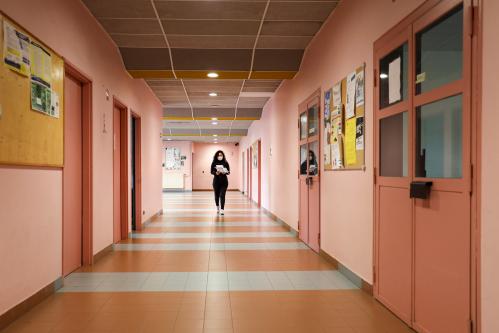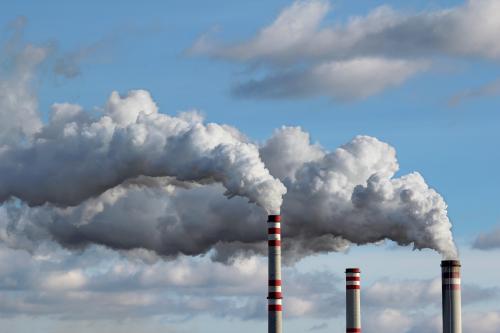The COVID-19 pandemic has brought about an increased focus on public health, particularly in school settings. From social distancing to testing regimes, education leaders are making serious changes to ensure that schools are safe for students, staff, and teachers. As the school experience continues to be reinvented, research points to an overlooked but potentially critical factor when thinking about reopening: air quality. While we have known for some time about the negative effects of air pollution on child health, recent evidence indicates that pollution also has detrimental effects on student learning. In turn, these relationships suggest the potential for some highly cost-effective interventions to raise student performance—and keep kids safer during the pandemic.
Evidence on the Effects of Pollution on Cognition
To date, most research has linked pollution to student learning using variation in outdoor air pollution. Researchers (see here and here) have documented significant declines in test scores when students take tests on days with high levels of particulate pollution. Another study compared students attending schools downwind relative to upwind of highways and found that increased air pollution from being downwind lowered test scores and raised behavioral incidents and absences. Similarly, in a recent working paper, a co-author and I use year-to-year variation in power production combined with wind direction to show that pollution from coal-fired power plants lower students’ test scores.
Several recent papers have been able to link indoor air quality to reduced cognitive performance. Research from chess tournaments found that a player’s probability of making an erroneous chess move (as determined by a chess engine) increased when particulate matter at the tournament venue was higher. An economist at the London School of Economics also linked indoor air quality to test performance. To do so, he collected air particulate readings in exam rooms at a university in London. He found that exam rooms at the university varied considerably in terms of air quality, and that students performed worse when they were assigned to exam rooms with higher levels of air pollution.
Reducing Children’s Pollution Exposure
Naturally, this evidence should spur policymakers to reduce children’s exposure to airborne pollutants. In general, the news has been positive on this front, with the average exposure to airborne pollutants in the United States declining by almost a third since 2000, according to satellite- and ground-based measures. These improvements have been driven by environmental regulations such as the Clean Air Act, along with the striking decline in coal use due to cheaper and cleaner alternatives, especially natural gas.
While the improvements in ambient air quality are commendable, children are also exposed to high levels of airborne pollutants indoors. Indoor air quality is a result of complex interactions between local meteorology, surrounding structures, and building characteristics (e.g., building ventilation, location of air intakes, etc.). Given this, indoor air pollution is highly spatially and temporally variable. For example, one of the key drivers of indoor air pollution is human movements causing the resuspension of settled dust, making it so that classroom air quality is worst when students enter/exit classes for recess or lunch. Researchers in London found that air quality inside classrooms was worse than the air quality outside. Given that students spend one-half of their waking time on weekdays at school, such evidence spotlights schools as a natural location to reduce students’ exposure to air pollution.
In that vein, one way to improve air quality inside classrooms is to upgrade aging schools. Research in this area has been promising, with one study in Texas looking at mold and ventilation remediation projects and finding that these renovations substantially raised test scores by about 0.1-0.15 of a standard deviation. These projects were costly, however, with the average remediation project costing between $300,000 and $500,000. Similar beneficial effects on test scores have been found using new school construction, although these entail even higher costs.
Similar gains can potentially be achieved in a more cost-effective manner. If improved indoor air quality is the driving force behind the large test-score effects of renovated and new schools, then policymakers can target air quality directly. A candidate to do so is plug-in air filters, which are relatively cheap (around $700 per unit) and which have been found to reduce airborne pollutants in classrooms by about 90%. These filters can even reduce virus-containing aerosol particles, with obvious implications for classroom safety in our current pandemic.
On this theme, a unique situation arose whereby air filters were installed in some classrooms in Los Angeles. Specifically, the Southern California Gas Company experienced a large leak at their Aliso Canyon gas storage facility in October 2015 that lasted until February 2016. Understandably, the gas leak generated substantial concerns in nearby neighborhoods, prompting the gas company to pay for voluntary evacuation expenses along with home improvements for those that stayed, including installing air filters and weatherizing homes. The gas company also provided 1,756 plug-in air filters to schools within five miles of the leak.
I investigated the effect of these air filters by comparing schools that received the air filters to nearby schools that did not. I found that schools receiving air filters experienced large test score gains of 0.1-0.2 of a standard deviation that year, particularly in mathematics. These test score gains were similar in magnitude to those from the renovation and school construction studies, but were achieved at a fraction of the cost. While the study relies on a relatively small sample of 11 schools that received the air filters (in comparison to 17 nearby schools that did not), it reinforces the prior evidence that improving air quality inside schools helps students succeed.
The Future of Clean Air in Classrooms
We now have compelling evidence that air quality affects student learning. Low-cost interventions such as air filters may be able to deliver the promised health and academic benefits of cleaner air in classrooms, although more research is needed. More evidence will doubtless follow: For example, the Clean Air, Sharp Minds Act introduced by Sen. Cory Booker (D-N.J.) and Rep. Katherine Clark (D-Mass.) aims to provide $20 million in grants for schools to purchase, install, and maintain commercial air filters and for their impact on learning to be assessed.
While we wait for further evidence, common-sense actions can be taken to reduce the impact of pollution on students. For starters, school officials should avoid locating new schools near highways: California, for instance, banned the construction of schools within 500 feet of freeways in 2003. For the nearly 8,000 existing schools within 500 feet of heavily trafficked roads, officials should test classrooms’ air quality and provide air filters in cases where air quality is poor. Such actions can improve student health and academic performance and, given that economically disadvantaged students disproportionately attend schools in highly polluted regions, help reduce pervasive test-score gaps in public education.





Commentary
The importance of clean air in classrooms—during the pandemic and beyond
October 28, 2020